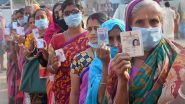Beijing [China], August 10 (ANI): The new COVID-19 outbreak in Southwest China's Xizang (Tibet) Autonomous Region raises grave concern across the region amid the lack of medical personnel and nucleic acid testing sample collectors, as well as a shortage of oxygen for treating severe cases due to its high altitude.
"Now the hospital doesn't have enough manpower to deal with the sudden COVID-19 flare-up, even if we dispatched all its medical workers, including the administrative staff against the epidemic," a staffer from a functional department of the Xigaze Tibetan Hospital told the Global Times on Tuesday.
Also Read | US Lawmakers Introduce Bill to Provide Citizenship to Afghan Refugees.
A doctor from the Lhasa People's Hospital said, "The treatment of mild cases is not a big problem for Xizang, as makeshift hospitals are arranged to take care of them, but the treatment of severe cases would be a challenge due to the lack of oxygen in the high-altitude location and limited medical equipment."
Xizang (Tibet) Autonomous Region, home to about 800,000 people reported 27 cases on Tuesday, Global Times reported.
Also Read | Langya Henipavirus Hits China, 35 People Infected: Report.
According to the Xizang regional health commission, the youngest patient is two and a half, and the eldest so far is a 76-year-old woman.
Based on gene sequencing tests, a local health official said that the COVID-19 cases detected in Lhasa, capital of Southwest China's Xizang (Tibet) Autonomous Region, were a family cluster infection caused by imported Omicron subvariant BA.2.76.
Earlier, it reported 22 cases since Sunday out of which 18 cases were found in Lhasa and four cases were found earlier in Ngari Prefecture's Burang county, marking the end of the region's 920-day record of no cases. The majority of those cases showed no symptoms.
The Chinese authorities have temporarily closed the World heritage sites Potala Palace and Norbulingka, as well as Tibet Museum in Lhasa to visitors on Tuesday with an undetermined reopening date amid the new surge in COVID-19 cases.
Lhasa announced plans to implement "static management" in medium- and high-risk areas, and cross-city travellers in low-risk areas will be required to present a 48-hour negative nucleic acid testing result, Global Times reported.
Xigaze on Monday put the whole city under a three-day static management, with nobody allowed to enter or leave the city. It means that local residents must stay indoors and public transportation is suspended, in what officials call "static management".
In Northwest China's Xinjiang Uygur Autonomous Region, COVID-19 infections continued to rise on Tuesday after 10 days of epidemic handling. The daily tally on Monday was 146, taking total infections to 420 as of press time.
Since the first case was found on July 30, the Xinjiang region has seen at least 12 counties in seven prefectures hit by COVID-19, Global Times reported.
A medical expert specializing in epidemic prevention and control, Zhang Yuexin said, "The challenge for Xinjiang is that more cases still can be found among communities, which indicates that the transmission chain has yet to be cut off."
"This wave of Xinjiang's outbreak originated from imported goods in Ili Kazak Autonomous Prefecture. How to better keep out virus transmission from overseas cargo is a long-term test for Xinjiang," he added.
Officials from the local health authority said that the Xinjiang region has been hit by multiple sporadic clusters of COVID-19 infections, and the current epidemic prevention and control situation is still grim.
According to data from the Xinjiang Uygur Autonomous Region's Department of Culture and Tourism, the Xinjiang region has witnessed a surge in the number of tourists this summer.
The Gatherings of people and cross-regional movement may have potentially increased the transmission of the virus and the risk of its spread inside and outside Xinjiang, health authorities said.
Meanwhile, Sanya city in Hainan province sent back the first batch of 125 tourists to Xi'an in Northwest China's Shaanxi Province. The city known as the "Hawaii of China" and one of the most famous tourism destinations in China had a total of 80,000 stranded.
The Hainan province, with a population of more than 10 million reported 40 new local infections on Tuesday, bringing cumulative infections to 1,899, including 1,558 infections in Sanya.
The sudden flare-up in Hainan caused by the Omicron BA5.1.3 variant started from the central fishing port of Yazhou district in Sanya, and around 180,000 tourists were stranded in the province as of Sunday. (ANI)
(This is an unedited and auto-generated story from Syndicated News feed, LatestLY Staff may not have modified or edited the content body)














 Quickly
Quickly
















